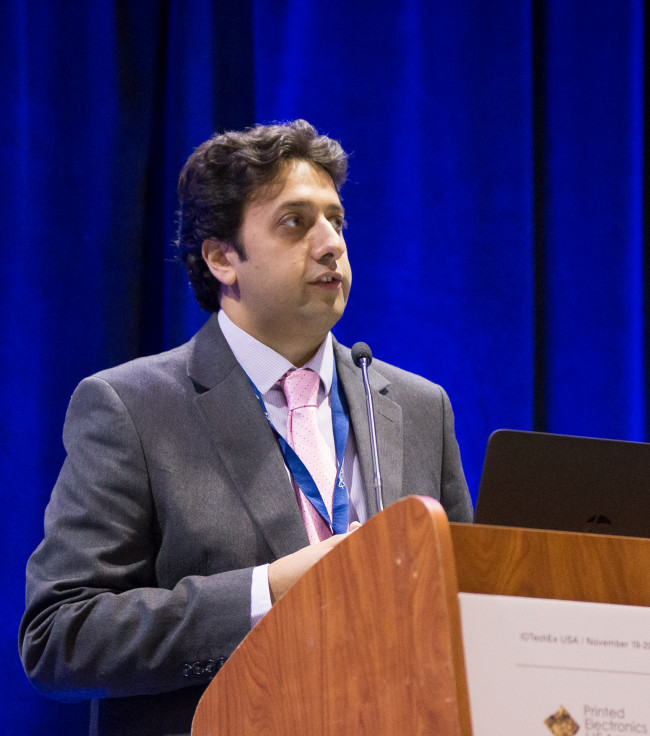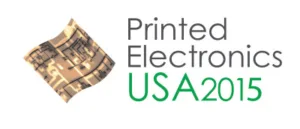The 2015 Printed Electronics Conference (Santa Clara, CA, November 17-20) organized by IDTechEx enjoyed another expansionary year with growth in attendance to more than 3000 and an expanded exhibit as well. As has been the case the past several years, the meeting was organized around a core of Printed and Flexible Electronics sessions and exhibits. Complementing these topics were parallel conference sessions on Sensors, 3D Printing, Energy Harvesting and Storage, Electric Vehicles, Internet of Things Applications, Wearable Technology, as well as Graphene and 2D Materials.

As I have noted previously, while these topics may seem impossibly diverse, they are increasingly linked, and the conference organizers noted that attendee feedback has been very strong for the content and programming of the event. The growth in attendance and exhibit space appears to support this argument.
 Raghu Das of IdTechEx – Image:IdTechExIn his opening keynote address, Raghu Das, CEO IDTechEx, presented his firm’s rationale for the diverse technology and application areas for the event. Das noted that there is broad participation in the event from all segments of the industry food chain, from materials suppliers, equipment manufacturers, startups and new product developers right on out to multinational system integrators and software solution providers. While conference sponsors came from some smaller and midsize firms, additional sponsors comprised large global materials suppliers including Wacker, Heraeus, and Agfa, as well as IBM and Qualcomm.
Raghu Das of IdTechEx – Image:IdTechExIn his opening keynote address, Raghu Das, CEO IDTechEx, presented his firm’s rationale for the diverse technology and application areas for the event. Das noted that there is broad participation in the event from all segments of the industry food chain, from materials suppliers, equipment manufacturers, startups and new product developers right on out to multinational system integrators and software solution providers. While conference sponsors came from some smaller and midsize firms, additional sponsors comprised large global materials suppliers including Wacker, Heraeus, and Agfa, as well as IBM and Qualcomm.
In his keynote, Raghu Das enumerated the current key trends for printed electronics and related segments. The first trend he cited was structural electronics whereby printed electronic components and systems are incorporated within the structure of products such as the leading edge of aircraft wings. The second trend Das noted was that after a long gestation period, printed electronic products are actually beginning to ship to customers from a number of firms including Polyera and Qualcomm. The third trend noted by Das was that Plastic and Flexible Electronics manufacturing is finally becoming center stage in the US, Europe as well as Asia. He also noted that the large electronic manufacturing services (EMS) firms are now very active in providing services for plastic and flexible electronics products.
The fourth trend cited by Das, was wearable technology. He noted that, in compiling the conference track on wearable technology, the organizers sought to bring the fashion industry to the event as well as technologists since design is such a critical factor in the development and success of wearable products. The wearable track includes sessions focusing on manufacturing for wearable electronics, smart clothing and skin patches, wearable technology in fashion, as well as innovations enabling wearable technology. Das noted that his fifth trend is stretchable electronics and indeed DuPont was on the program reporting on their interest and efforts in Manufacturing Stretchable Electronics. The sixth trend was the substantial investments being made to drive ahead plastic and flexible electronics manufacturing and he cited LG’s announcement of a $900 million investment in manufacturing for flexible OLED displays.
The seventh, eighth, ninth and tenth trends included the wirelessly connected internet of things (IoT), energy harvesting, sensor proliferation, and advanced new materials now coming to market. The balance of the diverse range of keynotes Wednesday, November 18 was presented by the US Olympic Committee, Hewlett-Packard, and Qualcomm. As this range of keynotes illustrates, plastic and flexible electronics and the related topics covered at this conference are of interest to a wide range of constituents. Several more interesting developments were reported on at the conference and I will continue to follow events here in Santa Clara for Display Daily’s subscribers in the coming days. – Phil Wright

